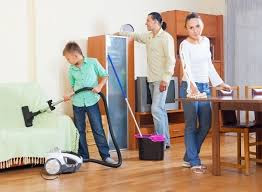Should you pay your child an allowance? There are many views on this, but here is my take.
Let me start first with a basic
premise: Children are a part
of a family, and a family works together and plays together. There are tasks that need to be done for the
family to function well, and each person should have tasks assigned to
them. No one pays Mom to make supper or
do the grocery shopping—it is an act of love that benefits the family. No one pays Dad to mow the lawn or change the
oil in the cars—it is an act of love that is done because he loves his family
and cares for the needs of his family.


When the family goes somewhere, everyone benefits. Meals are purchased, park entrance fees are
covered, hotels are paid for, etc. No
one asks their young child to pay the toll on the Turnpike! Things are covered because the family is on
an outing or going about life in general.
It is understood that the cost is absorbed by the family budget.
My Philosophy:
So….my philosophy is that all children should be given tasks
appropriate for their age, just because they are part of the family. Tasks and chores help develop character and
independence. (See my blog on, “How
to Develop Independence in Children”.) As children age, their responsibilities in the
home should keep pace. I do not think children should be “paid” for doing what
needs to be done to care for their toys, clothes, or other household needs. These are things that will need to be done
all of their life and are building blocks to independent living.
Allowance?
Children can be given a set amount of money for their own
use, an “allowance” if you will, just because they are part of the family, but
I don’t think that it should be because they have, “done their chores”. It is
because they are part of the family, not tied to completion of tasks. Giving children an allowance will also give
them experience in using money wisely (see below).
Earning Money:
It is important to teach children the value of money—how to
earn money, save money, and invest money. The old adage holds true, “Money doesn’t
grow on trees.” Money is earned. If a child holds out their hand and instantly
it is covered in a greenback, it teaches children to depend on others and does
not teach the correlation between work, income, budget, and spending.
Therefore, I believe that children should have the
opportunity to “work” and get paid.
Beyond their regular chores, children should be offered “jobs” around
the house that are extra and have a monetary reimbursement attached. Some things that could be on the list each
week: clean the refrigerator, sweep the
garage, clean the oven, wash walls, weed the garden, dust the mini blinds, water
the garden, etc. Children can choose
which jobs they want to attack; they are paid when the job is completed and
passes adult inspection.
Teach Children Wise Use of Money:
Children need to learn that every penny that comes into
their possession should not be immediately spent on their personal consumption.
We follow the 10-10-80 principle. Ten
percent of income (whether allowance or payment) should be donated (to a
church, synagogue, or charity), 10 percent saved (in a piggy bank for young
children or in a savings account for older children), and 80 percent used for
expenses. If children want a special
toy, DVD, article of clothing, or activity, they should be encouraged to save
the 80 percent until they have enough to purchase the item.
Additional Tips and Advice:
When on vacation, we always bought one T-shirt for everyone
and then gave each child a set amount of “spending” money. They were free to purchase a souvenir or
other items during the vacation. They
could also bring more of their saved money to spend, but there was to be no
begging and pleading for other things or more spending money. This prevented many a headache!
Older children can be allotted a set budget for specific
items and then given the freedom to use that money wisely. For instance, teenagers could be given a set
amount of money to spend on clothing or school supplies. They can buy what they want, but when the budgeted
money is gone, additional shopping is at their own expense.
An allowance should be graduated according to a child’s
age. You might want to use a formula of
$.50 or $1.00 per year of age so that a 5-year old would get $2.50 (or $5.00) a
week and a 10-year old $5.00 (or $10.00) a week.
Our older children were offered a summer job de-tasseling
corn for a large seed company in rural Indiana. It was a hot, scratchy, tiring
job. They earned a considerable amount
of money for this “first job” experience, but our son learned a very valuable
lesson later that summer that was worth way more than the paycheck! We were attending a county fair as a family.
There was a booth that offered helicopter rides for a fee. Our son turned to his dad and asked to ride
the helicopter. His dad told him, “You
have money now. You can pay for this.”
Our son mulled this over in his mind and declined the opportunity after
reasoning and calculating how many hours the 15-minute ride would cost him in
terms of the back-breaking labor he experienced earning that money!
MORAL: When
YOU have worked for the money, more time and discretion is used before it is
spent!
MORAL: When
YOU have worked for the money, more time and discretion is used before it is
spent!
Blog Administrator: Trisha Roberts
proeducationaltoys@gmail.com
Copyright © 2017 TNT Inspired Enterprise, LLC, All rights reserved.
Unauthorized duplication is a violation of applicable laws.
































